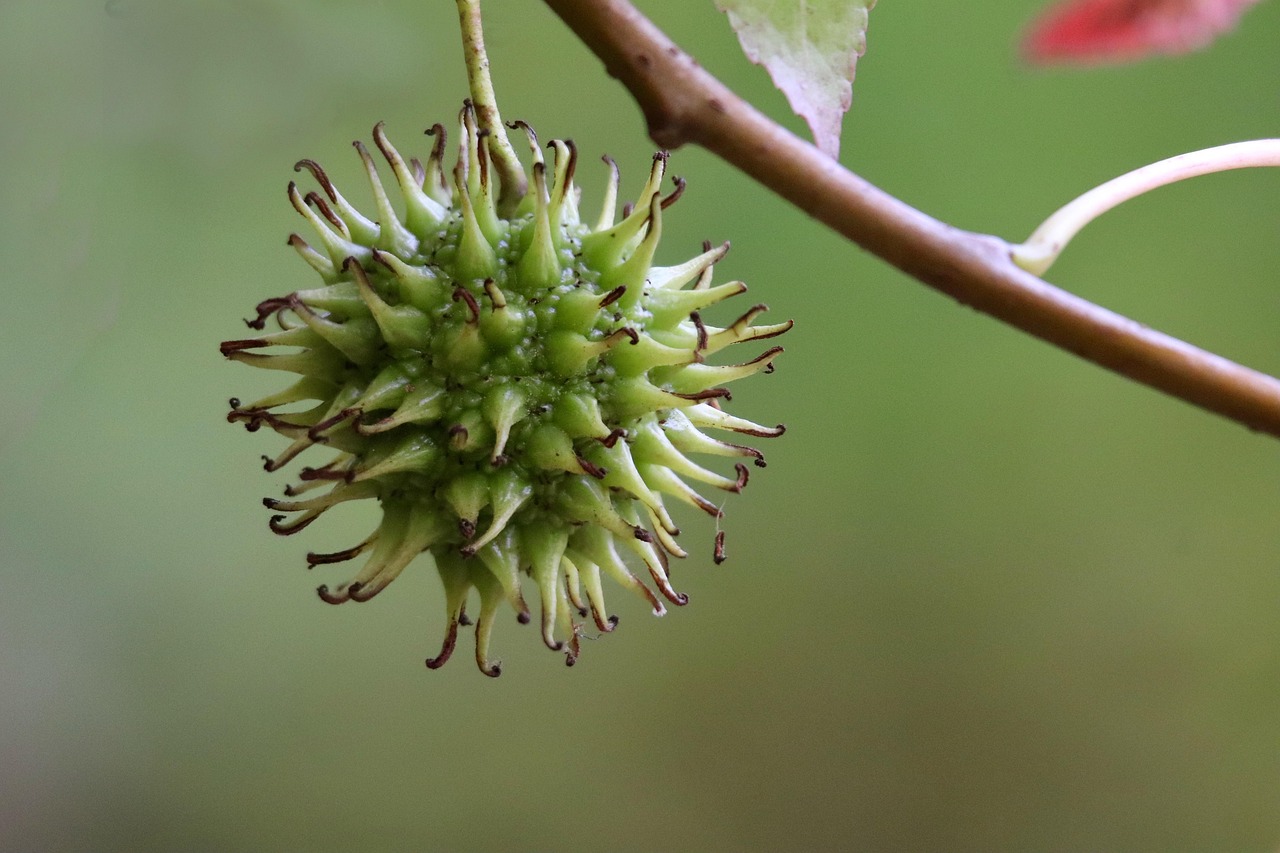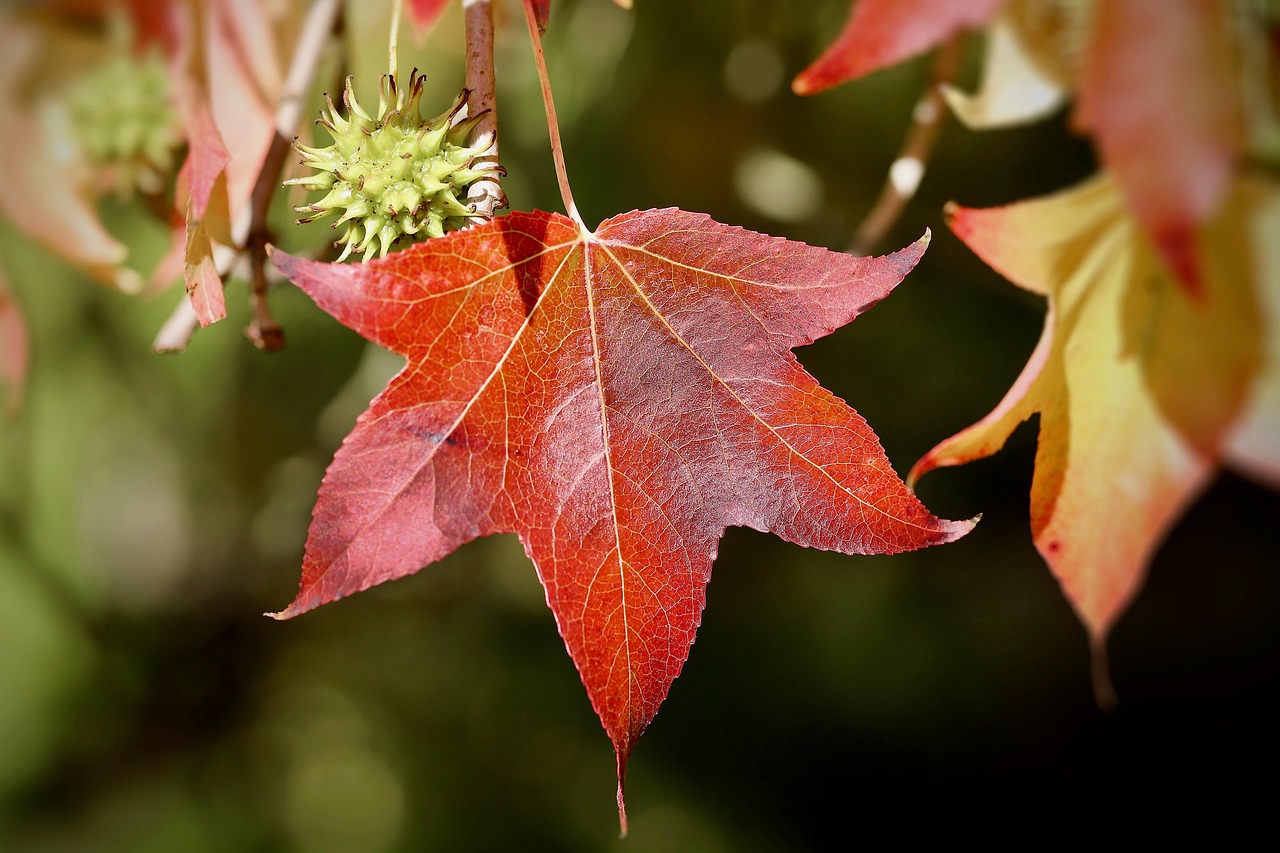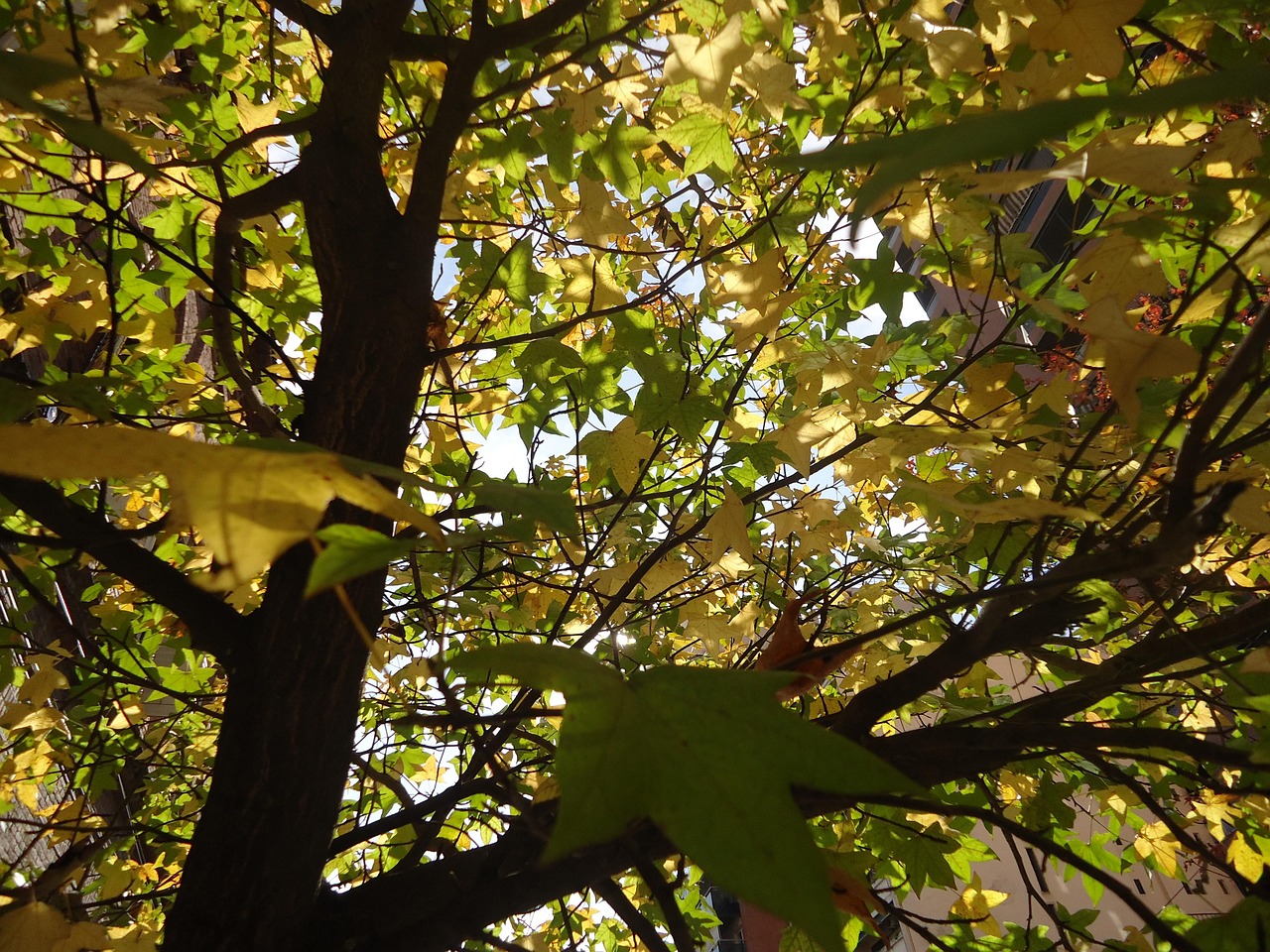The Sweetgum tree, scientifically known as Liquidambar styraciflua, is a deciduous tree native to the southeastern United States. Its distinctive star-shaped leaves and spiky seed balls make it a unique addition to various landscapes.
Understanding the Sweetgum Tree

The Sweetgum tree is renowned for its striking appearance and ecological benefits. This tree can grow up to 100 feet tall and often features a straight trunk with a broad, open canopy. The leaves are typically star-shaped with five pointed lobes, turning vibrant shades of yellow, orange, and red in the fall. These seasonal changes contribute to its appeal in ornamental horticulture.
Sweetgum trees thrive in well-drained soils and are commonly found in mixed hardwood forests. They are highly adaptable, flourishing in various environmental conditions, from wet lowlands to dry uplands. The tree is also tolerant of urban pollution, making it a popular choice for city landscapes.
In addition to their aesthetic value, Sweetgum trees provide numerous ecological benefits. They offer habitat for wildlife, including birds and small mammals. The tree’s flowers provide nectar for pollinators such as bees. Furthermore, the unique seed balls that fall from the tree serve as a food source for various species.
Physical Characteristics
The Sweetgum tree possesses several distinctive physical traits. The bark is typically gray and furrowed, while the leaves exhibit a glossy green hue during the growing season. As autumn approaches, the foliage transforms into a colorful display of reds and yellows. The tree’s fruit is a round, spiky seed ball that can be quite bothersome when it falls to the ground.
Here are some key physical characteristics of the Sweetgum tree:
| Characteristic | Description |
|---|---|
| Height | Up to 100 feet |
| Leaf Shape | Star-shaped with five lobes |
| Bark | Gray and furrowed |
| Fruit | Spiky seed balls |
Habitat and Distribution
The Sweetgum tree primarily grows in the southeastern regions of the United States but can also be found in parts of Mexico and Central America. It thrives in various habitats, including wetland areas, floodplains, and upland forests. The tree prefers a climate that offers warm summers and moderate winters, although it can tolerate some colder conditions.
Its widespread distribution makes it an integral component of many ecosystems. Sweetgum trees often grow alongside other hardwood species like oaks and maples, contributing to the biodiversity of their environments.
In urban settings, Sweetgum trees are commonly planted for their shade and beauty. However, their spiky seed balls can be a drawback for homeowners looking for low-maintenance landscaping options.
Cultural Significance of the Sweetgum Tree
The Sweetgum tree holds cultural significance in various regions, particularly in the southeastern United States. It has become a symbol of resilience and adaptability due to its robust nature and ability to thrive in diverse environments. Historically, Native American tribes utilized the tree for different purposes, showcasing its importance in traditional practices.
One notable use of Sweetgum was for medicinal purposes. The resin extracted from the tree was used as a remedy for various ailments, including respiratory issues. This natural remedy highlights the tree’s value beyond its aesthetic appeal.
Uses of the Sweetgum Tree
The Sweetgum tree serves multiple purposes, both ecological and practical. Its hardwood is valued for its durability and beauty, making it suitable for various applications. Here are some common uses:
- Furniture: Sweetgum wood is commonly used to make furniture due to its attractive grain and strength.
- Cabinetry: The wood is also popular in cabinetry and millwork, providing a classic look for interior spaces.
- Musical Instruments: Some musical instruments, like drums, are crafted from Sweetgum wood because of its resonant qualities.
- Ornamental Planting: The tree is frequently planted for landscaping purposes, enhancing urban and residential areas with its striking fall colors.
In addition to these uses, the tree’s spiky seed balls can be composted or used as mulch. However, it’s worth noting that they can be cumbersome for homeowners who prefer a tidy yard.
Growth and Care of the Sweetgum Tree
Growing a Sweetgum tree can be a rewarding experience. With proper care, it can thrive for decades. Here are some important considerations for planting and maintaining this tree:
Planting Conditions
When planting a Sweetgum tree, the following conditions should be considered:
- Soil Type: Sweetgum trees prefer well-drained soils. They can tolerate clay, loam, or sandy soils.
- Sunlight: Full sun is ideal for optimal growth. A location that receives at least six hours of sunlight per day is recommended.
- Watering: Regular watering is essential, especially during dry spells. Newly planted trees should be watered frequently until established.
Maintenance Tips
Maintaining a Sweetgum tree involves several key practices:
- Pruning: Prune the tree during its dormant season to remove dead or damaged branches. This encourages healthy growth.
- Pest Management: Keep an eye out for pests such as aphids and spider mites. Treat infestations promptly using appropriate methods.
- Fertilization: Apply a balanced fertilizer in early spring to promote vigorous growth.
With appropriate care, Sweetgum trees can live for over 100 years, providing beauty and ecological benefits throughout their lifespan.
Pests and Diseases
Like any tree species, Sweetgum trees are susceptible to certain pests and diseases. Understanding these threats is crucial for effective management.
Common pests include:
- Aphids: These small insects can cause leaf curling and may lead to sooty mold buildup on leaves.
- Spider Mites: These pests thrive in hot, dry conditions and can weaken the tree by sucking sap from leaves.
Diseases that may affect Sweetgum trees include:
- Canker Diseases: These can occur when fungal infections penetrate the bark, leading to branch dieback.
- Leaf Spot: Caused by fungi or bacteria, leaf spots can reduce photosynthesis and overall health if left untreated.
Regular monitoring and early intervention are key strategies for managing these issues effectively, ensuring the long-term health of the Sweetgum tree.

Environmental Benefits of the Sweetgum Tree
The Sweetgum tree offers numerous environmental benefits that play a crucial role in maintaining healthy ecosystems. Its presence contributes to biodiversity, improves air quality, and supports wildlife habitats.
Biodiversity Support
One of the significant contributions of the Sweetgum tree is its ability to support biodiversity. By providing food and habitat for various species, it becomes an integral part of its ecosystem. Here are some ways it supports biodiversity:
- Habitat: The tree serves as a home for birds, small mammals, and insects. The dense canopy provides shelter, while the tree’s bark offers nesting sites.
- Food Source: The flowers of the Sweetgum tree attract pollinators, such as bees and butterflies. Additionally, the spiky seed balls serve as a food source for squirrels and other wildlife.
- Soil Health: The fallen leaves and organic matter from the tree enrich the soil, promoting a healthy environment for various plants and organisms.
Air Quality Improvement
Sweetgum trees play a vital role in improving air quality. Through the process of photosynthesis, they absorb carbon dioxide and release oxygen. This helps to mitigate the effects of pollution in urban areas where these trees are often planted. Here are some specific benefits related to air quality:
- Carbon Sequestration: Sweetgum trees capture and store carbon dioxide from the atmosphere, which helps to combat climate change.
- Oxygen Production: A mature Sweetgum tree can produce a significant amount of oxygen, contributing to cleaner air.
- Dust Reduction: The tree’s leaves can trap dust and particulate matter, improving air cleanliness in its vicinity.
Cultural Uses and Aesthetic Value
T

he Sweetgum tree is not only valued for its ecological benefits but also for its cultural significance and aesthetic appeal. Its striking appearance makes it a popular choice for landscaping and public parks.
Aesthetic Appeal
The unique shape of the Sweetgum tree, combined with its vibrant fall colors, enhances the beauty of any landscape. Key features that contribute to its aesthetic value include:
- Fall Foliage: The leaves change to brilliant hues of red, orange, and yellow in autumn, creating stunning visual displays.
- Distinctive Shape: The tree has a characteristic pyramidal shape when young, which matures into a broad canopy, providing shade and beauty.
- Year-Round Interest: Even in winter, the structure of the tree can be visually appealing, especially when adorned with frost or snow.
Cultural Significance
The Sweetgum tree has historical importance, particularly among Native American tribes. Its resin was used for various purposes, showcasing its utilitarian value. Here are some cultural uses of the Sweetgum tree:
- Medicinal Uses: Native Americans historically used the resin for treating respiratory conditions and wounds.
- Ceremonial Uses: The tree has been featured in various cultural practices and ceremonies, symbolizing strength and endurance.
Challenges in Cultivation
While the Sweetgum tree is a resilient species, there are challenges associated with its cultivation. Understanding these challenges can help gardeners and landscapers make informed decisions.
Maintenance Challenges
The primary challenges in maintaining Sweetgum trees include:
- Seed Ball Cleanup: The spiky seed balls can create litter on lawns and pathways. Regular cleanup may be necessary to maintain aesthetics.
- Pest Management: As previously mentioned, pests like aphids and spider mites require monitoring and management to prevent infestations.
- Space Requirements: Given their potential height and spread, Sweetgum trees require ample space. Planting them too close to structures or other trees can lead to competition for resources.
By addressing these challenges with appropriate care and management strategies, the benefits of planting Sweetgum trees can far outweigh any drawbacks.
Ecological Impact of Sweetgum Trees
The role of Sweetgum trees in ecosystems extends beyond their visual appeal and cultural significance. They play a vital ecological role that contributes to the health of their environment. Understanding their impact can help us appreciate why preserving and planting these trees is essential.
Soil Improvement
Sweetgum trees enhance soil quality through their leaf litter, which breaks down and enriches the soil with organic matter. This process supports various soil organisms, fostering a healthy ecosystem. Key aspects include:
- Nutrient Recycling: The decomposition of fallen leaves and organic material returns vital nutrients to the soil, benefiting surrounding plants.
- Soil Structure: The root system of the Sweetgum tree helps improve soil aeration and drainage, promoting better growth for other plants.
- Encouraging Microbial Life: The organic matter from Sweetgum trees provides a habitat for beneficial microorganisms that aid in nutrient cycling.
Climate Adaptability
Sweetgum trees are known for their adaptability to various climate conditions. They can thrive in both wet and dry environments, which makes them a valuable species in the face of climate change. Their resilience helps maintain stability in ecosystems, especially as weather patterns become more unpredictable.
Community Engagement and Education
E

ngaging the community in understanding the significance of Sweetgum trees can foster appreciation for local biodiversity and promote conservation efforts. Educational initiatives can include:
- Workshops: Organizing workshops on tree care can empower homeowners to plant and maintain Sweetgum trees effectively.
- School Programs: Incorporating information about Sweetgum trees into school curricula can educate children about local ecology.
- Community Planting Days: Hosting events where community members can plant Sweetgum trees encourages environmental stewardship and fosters community spirit.
By involving the community, we can ensure that future generations recognize the value of Sweetgum trees and contribute to their preservation.
Final Thoughts
In conclusion, the Sweetgum tree is a distinctive and valuable species that offers numerous ecological, aesthetic, and cultural benefits. Its impressive height, vibrant fall colors, and unique seed balls make it a standout in various landscapes. Despite some maintenance challenges, the rewards of planting and caring for a Sweetgum tree far outweigh the drawbacks.
Understanding the environmental benefits, such as improving air quality, supporting biodiversity, and enriching soil, highlights its importance in both urban and natural settings. Furthermore, engaging communities in the appreciation and stewardship of Sweetgum trees fosters a deeper connection to nature.
As we face pressing environmental challenges, recognizing the value of trees like the Sweetgum can inspire action toward conservation and sustainability. By planting these trees, we not only enhance our landscapes but also contribute positively to our ecosystems for generations to come.
